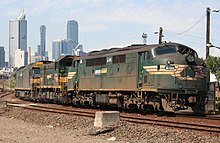This article needs additional citations for verification. (December 2019) |



A diesel locomotive is a type of railway locomotive in which the power source is a diesel engine. Several types of diesel locomotives have been developed, differing mainly in the means by which mechanical power is conveyed to the driving wheels. The most common are diesel–electric locomotives and diesel–hydraulic.
Early internal combustion locomotives and railcars used kerosene and gasoline as their fuel. Rudolf Diesel patented his first compression-ignition engine[2] in 1898, and steady improvements to the design of diesel engines reduced their physical size and improved their power-to-weight ratios to a point where one could be mounted in a locomotive. Internal combustion engines only operate efficiently within a limited power band, and while low-power gasoline engines could be coupled to mechanical transmissions, the more powerful diesel engines required the development of new forms of transmission.[3][4][5][6][7] This is because clutches would need to be very large at these power levels and would not fit in a standard 2.5 m (8 ft 2 in)-wide locomotive frame, or would wear too quickly to be useful.
The first successful diesel engines used diesel–electric transmissions, and by 1925 a small number of diesel locomotives of 600 hp (450 kW) were in service in the United States. In 1930, Armstrong Whitworth of the United Kingdom delivered two 1,200 hp (890 kW) locomotives using Sulzer-designed engines to Buenos Aires Great Southern Railway of Argentina. In 1933, diesel–electric technology developed by Maybach was used to propel the DRG Class SVT 877, a high-speed intercity two-car set, and went into series production with other streamlined car sets in Germany starting in 1935. In the United States, diesel–electric propulsion was brought to high-speed mainline passenger service in late 1934, largely through the research and development efforts of General Motors dating back to the late 1920s and advances in lightweight car body design by the Budd Company.
The economic recovery from World War II hastened the widespread adoption of diesel locomotives in many countries. They offered greater flexibility and performance than steam locomotives, as well as substantially lower operating and maintenance costs.[8]
- ^ "World's fastest diesel locomotive will run again at Ruddington". BBC News. British Broadcasting Corporation. 16 July 2021. Retrieved 22 July 2023.
- ^ U.S. 608,845, Rudolf Diesel, "Internal-combustion engine", issued 9 August 1898
- ^ Arnold Heller: Der Automobilmotor im Eisenbahnbetriebe, Leipzig 1906, reprinted by Salzwasserverlag 2011, ISBN 978-3-86444-240-7
- ^ Röll: Enzyklopädie des Eisenbahnwesens → Elektrische Eisenbahnen, there go to VII. Automobile Triebwagen → zu b Benzin-, Benzol- oder Gasolin-elektrischen Triebwagen
- ^ Raymond S Zeitler, American School (Chicago, Ill.): Self-Contained Railway Motor Cars and Locomotives, section SELF-CONTAINED RAILWAY CARS 57–59
- ^ Röll: Arader und Csanáder Eisenbahnen Vereinigte Aktien-Gesellschaft
- ^ Museal railcars of BHÉV and their history
- ^ "Diesel–Electric Locomotives". Diesel–Electric Locomotives. Union Pacific. Retrieved 12 May 2022.